Wireless Power Transfer: Applications and Future Trends Report
VerifiedAdded on 2023/03/17
|10
|1952
|59
Report
AI Summary
This report provides a comprehensive overview of Wireless Power Transfer (WPT), a technology that eliminates the need for wires in power transmission. It begins with an executive summary and introduction to the concept, explaining how WPT utilizes electromagnetic fields and the law of induction. The discussion section delves into the concept, highlighting the transmitter, receiver, and antenna, and differentiates between radioactive and non-radioactive techniques. The report explores new emerging technologies, such as WPT in electric vehicles and solar power satellites. It analyzes the impacts of WPT on future job skills for university graduates and lists pros and cons of the technology. Various applications are discussed, including electric vehicles, mobile phones, household and medical applications, and military uses. The report concludes by emphasizing the transformative potential of WPT and provides recommendations for its further development, along with references to relevant research papers.
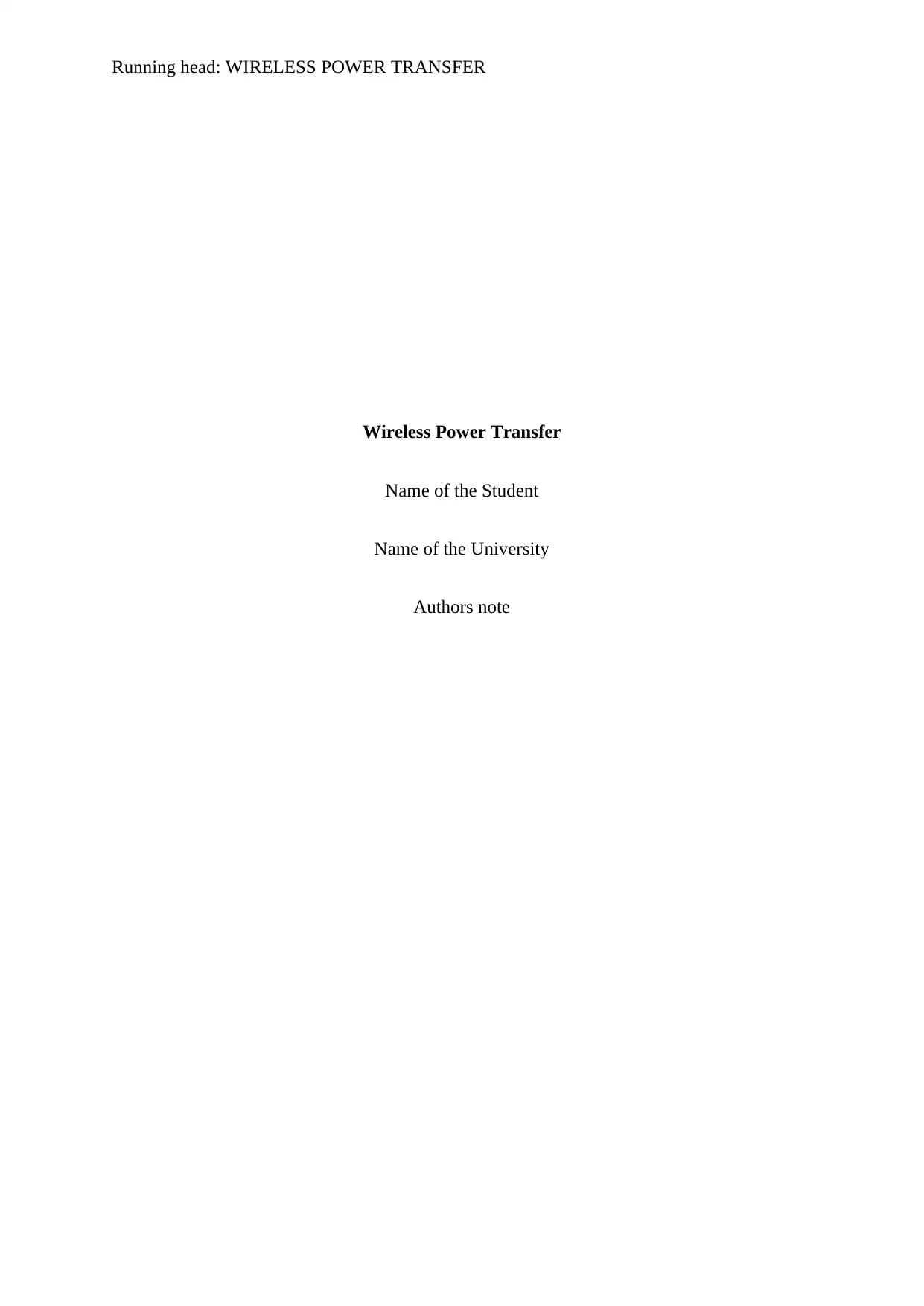
Running head: WIRELESS POWER TRANSFER
Wireless Power Transfer
Name of the Student
Name of the University
Authors note
Wireless Power Transfer
Name of the Student
Name of the University
Authors note
Paraphrase This Document
Need a fresh take? Get an instant paraphrase of this document with our AI Paraphraser
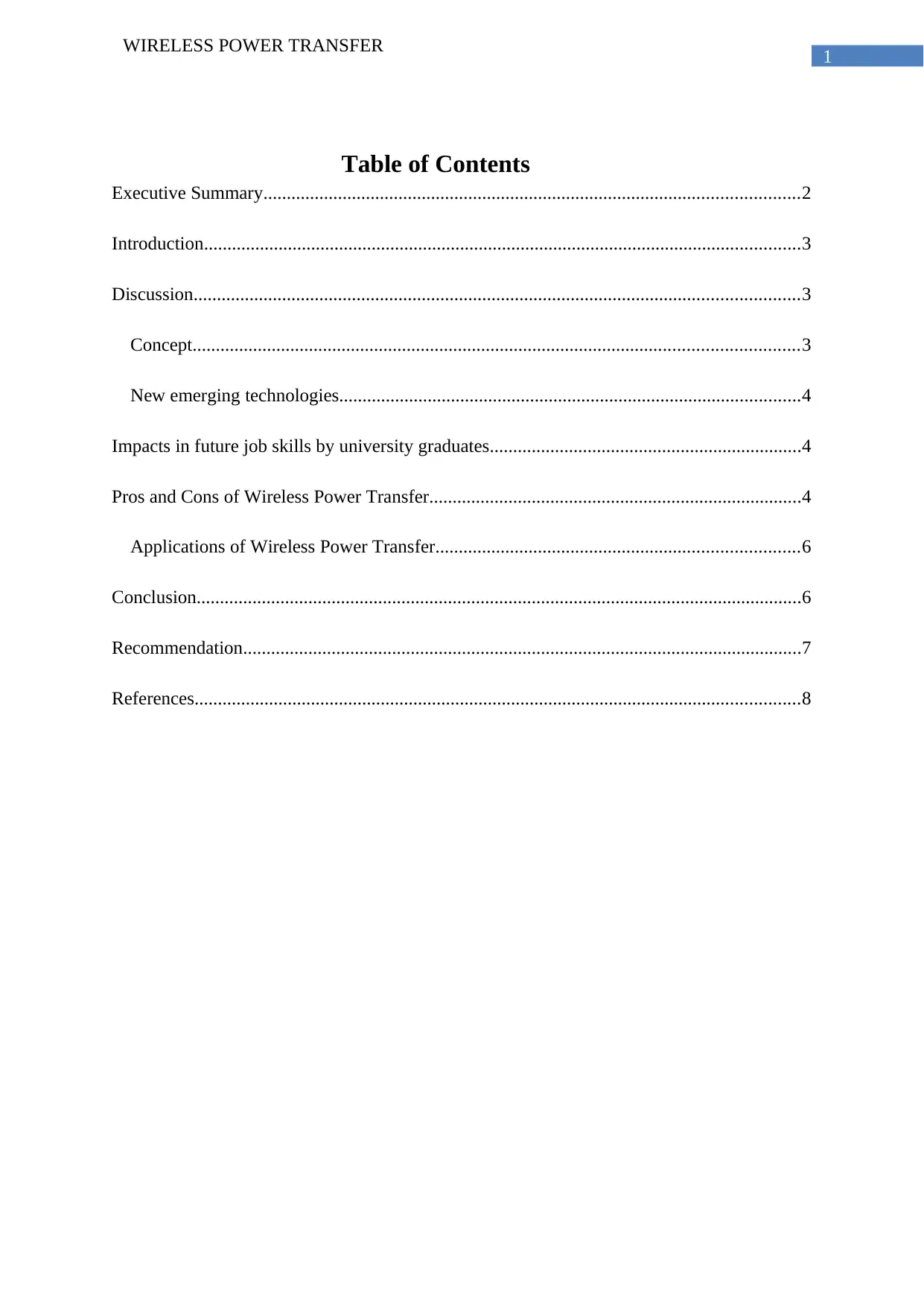
1
WIRELESS POWER TRANSFER
Table of Contents
Executive Summary...................................................................................................................2
Introduction................................................................................................................................3
Discussion..................................................................................................................................3
Concept..................................................................................................................................3
New emerging technologies...................................................................................................4
Impacts in future job skills by university graduates...................................................................4
Pros and Cons of Wireless Power Transfer................................................................................4
Applications of Wireless Power Transfer..............................................................................6
Conclusion..................................................................................................................................6
Recommendation........................................................................................................................7
References..................................................................................................................................8
WIRELESS POWER TRANSFER
Table of Contents
Executive Summary...................................................................................................................2
Introduction................................................................................................................................3
Discussion..................................................................................................................................3
Concept..................................................................................................................................3
New emerging technologies...................................................................................................4
Impacts in future job skills by university graduates...................................................................4
Pros and Cons of Wireless Power Transfer................................................................................4
Applications of Wireless Power Transfer..............................................................................6
Conclusion..................................................................................................................................6
Recommendation........................................................................................................................7
References..................................................................................................................................8
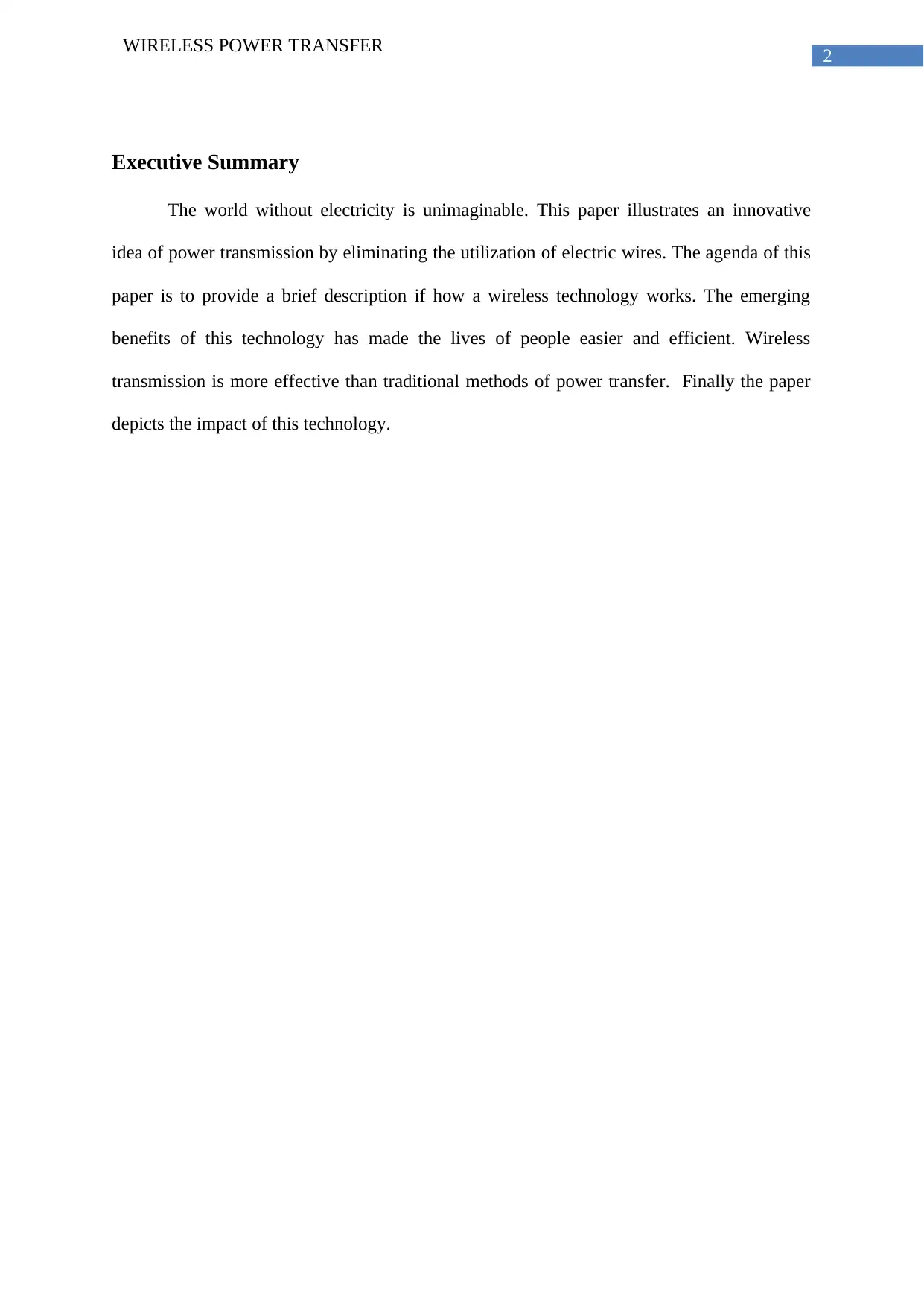
2
WIRELESS POWER TRANSFER
Executive Summary
The world without electricity is unimaginable. This paper illustrates an innovative
idea of power transmission by eliminating the utilization of electric wires. The agenda of this
paper is to provide a brief description if how a wireless technology works. The emerging
benefits of this technology has made the lives of people easier and efficient. Wireless
transmission is more effective than traditional methods of power transfer. Finally the paper
depicts the impact of this technology.
WIRELESS POWER TRANSFER
Executive Summary
The world without electricity is unimaginable. This paper illustrates an innovative
idea of power transmission by eliminating the utilization of electric wires. The agenda of this
paper is to provide a brief description if how a wireless technology works. The emerging
benefits of this technology has made the lives of people easier and efficient. Wireless
transmission is more effective than traditional methods of power transfer. Finally the paper
depicts the impact of this technology.
⊘ This is a preview!⊘
Do you want full access?
Subscribe today to unlock all pages.

Trusted by 1+ million students worldwide
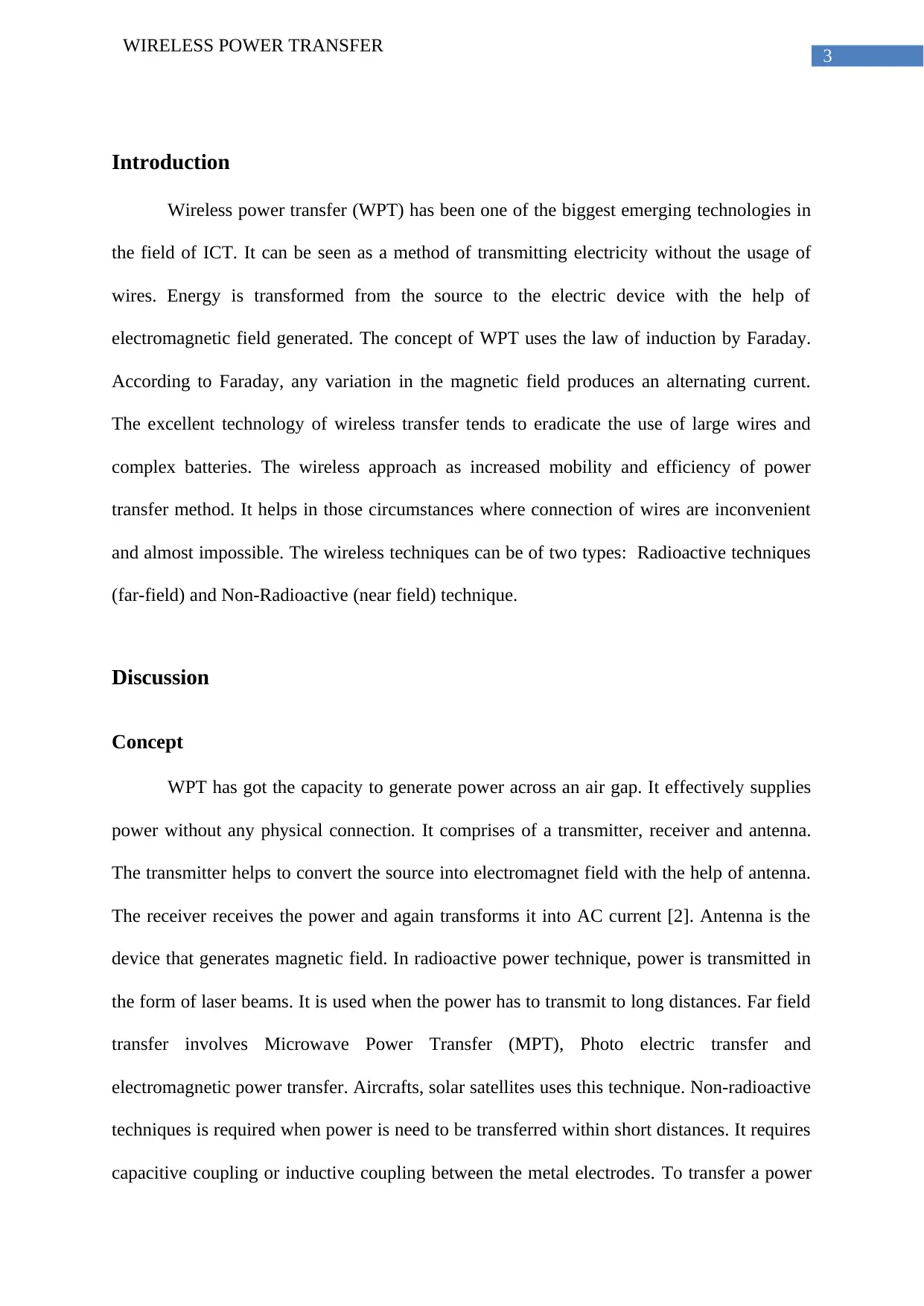
3
WIRELESS POWER TRANSFER
Introduction
Wireless power transfer (WPT) has been one of the biggest emerging technologies in
the field of ICT. It can be seen as a method of transmitting electricity without the usage of
wires. Energy is transformed from the source to the electric device with the help of
electromagnetic field generated. The concept of WPT uses the law of induction by Faraday.
According to Faraday, any variation in the magnetic field produces an alternating current.
The excellent technology of wireless transfer tends to eradicate the use of large wires and
complex batteries. The wireless approach as increased mobility and efficiency of power
transfer method. It helps in those circumstances where connection of wires are inconvenient
and almost impossible. The wireless techniques can be of two types: Radioactive techniques
(far-field) and Non-Radioactive (near field) technique.
Discussion
Concept
WPT has got the capacity to generate power across an air gap. It effectively supplies
power without any physical connection. It comprises of a transmitter, receiver and antenna.
The transmitter helps to convert the source into electromagnet field with the help of antenna.
The receiver receives the power and again transforms it into AC current [2]. Antenna is the
device that generates magnetic field. In radioactive power technique, power is transmitted in
the form of laser beams. It is used when the power has to transmit to long distances. Far field
transfer involves Microwave Power Transfer (MPT), Photo electric transfer and
electromagnetic power transfer. Aircrafts, solar satellites uses this technique. Non-radioactive
techniques is required when power is need to be transferred within short distances. It requires
capacitive coupling or inductive coupling between the metal electrodes. To transfer a power
WIRELESS POWER TRANSFER
Introduction
Wireless power transfer (WPT) has been one of the biggest emerging technologies in
the field of ICT. It can be seen as a method of transmitting electricity without the usage of
wires. Energy is transformed from the source to the electric device with the help of
electromagnetic field generated. The concept of WPT uses the law of induction by Faraday.
According to Faraday, any variation in the magnetic field produces an alternating current.
The excellent technology of wireless transfer tends to eradicate the use of large wires and
complex batteries. The wireless approach as increased mobility and efficiency of power
transfer method. It helps in those circumstances where connection of wires are inconvenient
and almost impossible. The wireless techniques can be of two types: Radioactive techniques
(far-field) and Non-Radioactive (near field) technique.
Discussion
Concept
WPT has got the capacity to generate power across an air gap. It effectively supplies
power without any physical connection. It comprises of a transmitter, receiver and antenna.
The transmitter helps to convert the source into electromagnet field with the help of antenna.
The receiver receives the power and again transforms it into AC current [2]. Antenna is the
device that generates magnetic field. In radioactive power technique, power is transmitted in
the form of laser beams. It is used when the power has to transmit to long distances. Far field
transfer involves Microwave Power Transfer (MPT), Photo electric transfer and
electromagnetic power transfer. Aircrafts, solar satellites uses this technique. Non-radioactive
techniques is required when power is need to be transferred within short distances. It requires
capacitive coupling or inductive coupling between the metal electrodes. To transfer a power
Paraphrase This Document
Need a fresh take? Get an instant paraphrase of this document with our AI Paraphraser
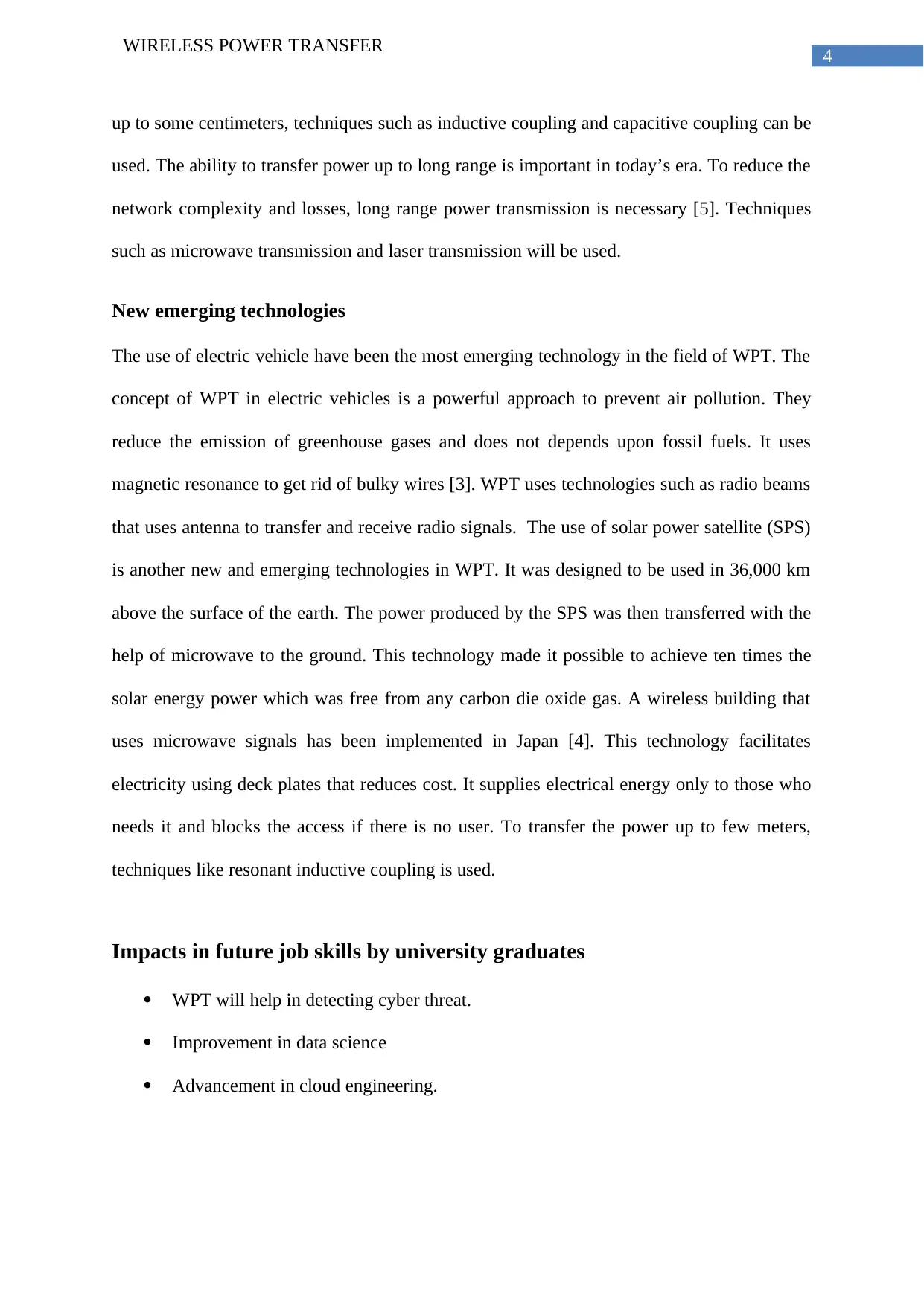
4
WIRELESS POWER TRANSFER
up to some centimeters, techniques such as inductive coupling and capacitive coupling can be
used. The ability to transfer power up to long range is important in today’s era. To reduce the
network complexity and losses, long range power transmission is necessary [5]. Techniques
such as microwave transmission and laser transmission will be used.
New emerging technologies
The use of electric vehicle have been the most emerging technology in the field of WPT. The
concept of WPT in electric vehicles is a powerful approach to prevent air pollution. They
reduce the emission of greenhouse gases and does not depends upon fossil fuels. It uses
magnetic resonance to get rid of bulky wires [3]. WPT uses technologies such as radio beams
that uses antenna to transfer and receive radio signals. The use of solar power satellite (SPS)
is another new and emerging technologies in WPT. It was designed to be used in 36,000 km
above the surface of the earth. The power produced by the SPS was then transferred with the
help of microwave to the ground. This technology made it possible to achieve ten times the
solar energy power which was free from any carbon die oxide gas. A wireless building that
uses microwave signals has been implemented in Japan [4]. This technology facilitates
electricity using deck plates that reduces cost. It supplies electrical energy only to those who
needs it and blocks the access if there is no user. To transfer the power up to few meters,
techniques like resonant inductive coupling is used.
Impacts in future job skills by university graduates
WPT will help in detecting cyber threat.
Improvement in data science
Advancement in cloud engineering.
WIRELESS POWER TRANSFER
up to some centimeters, techniques such as inductive coupling and capacitive coupling can be
used. The ability to transfer power up to long range is important in today’s era. To reduce the
network complexity and losses, long range power transmission is necessary [5]. Techniques
such as microwave transmission and laser transmission will be used.
New emerging technologies
The use of electric vehicle have been the most emerging technology in the field of WPT. The
concept of WPT in electric vehicles is a powerful approach to prevent air pollution. They
reduce the emission of greenhouse gases and does not depends upon fossil fuels. It uses
magnetic resonance to get rid of bulky wires [3]. WPT uses technologies such as radio beams
that uses antenna to transfer and receive radio signals. The use of solar power satellite (SPS)
is another new and emerging technologies in WPT. It was designed to be used in 36,000 km
above the surface of the earth. The power produced by the SPS was then transferred with the
help of microwave to the ground. This technology made it possible to achieve ten times the
solar energy power which was free from any carbon die oxide gas. A wireless building that
uses microwave signals has been implemented in Japan [4]. This technology facilitates
electricity using deck plates that reduces cost. It supplies electrical energy only to those who
needs it and blocks the access if there is no user. To transfer the power up to few meters,
techniques like resonant inductive coupling is used.
Impacts in future job skills by university graduates
WPT will help in detecting cyber threat.
Improvement in data science
Advancement in cloud engineering.
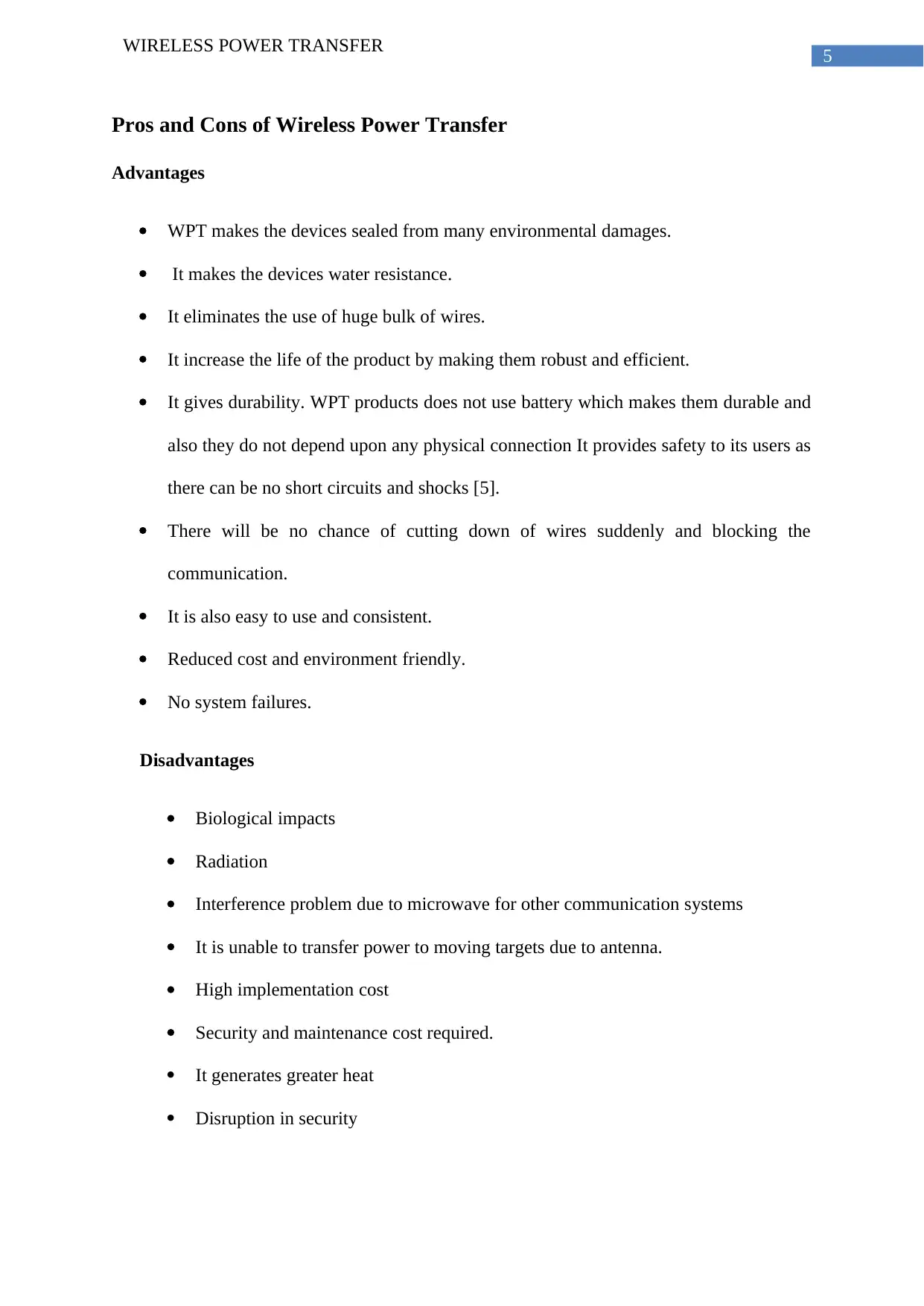
5
WIRELESS POWER TRANSFER
Pros and Cons of Wireless Power Transfer
Advantages
WPT makes the devices sealed from many environmental damages.
It makes the devices water resistance.
It eliminates the use of huge bulk of wires.
It increase the life of the product by making them robust and efficient.
It gives durability. WPT products does not use battery which makes them durable and
also they do not depend upon any physical connection It provides safety to its users as
there can be no short circuits and shocks [5].
There will be no chance of cutting down of wires suddenly and blocking the
communication.
It is also easy to use and consistent.
Reduced cost and environment friendly.
No system failures.
Disadvantages
Biological impacts
Radiation
Interference problem due to microwave for other communication systems
It is unable to transfer power to moving targets due to antenna.
High implementation cost
Security and maintenance cost required.
It generates greater heat
Disruption in security
WIRELESS POWER TRANSFER
Pros and Cons of Wireless Power Transfer
Advantages
WPT makes the devices sealed from many environmental damages.
It makes the devices water resistance.
It eliminates the use of huge bulk of wires.
It increase the life of the product by making them robust and efficient.
It gives durability. WPT products does not use battery which makes them durable and
also they do not depend upon any physical connection It provides safety to its users as
there can be no short circuits and shocks [5].
There will be no chance of cutting down of wires suddenly and blocking the
communication.
It is also easy to use and consistent.
Reduced cost and environment friendly.
No system failures.
Disadvantages
Biological impacts
Radiation
Interference problem due to microwave for other communication systems
It is unable to transfer power to moving targets due to antenna.
High implementation cost
Security and maintenance cost required.
It generates greater heat
Disruption in security
⊘ This is a preview!⊘
Do you want full access?
Subscribe today to unlock all pages.

Trusted by 1+ million students worldwide
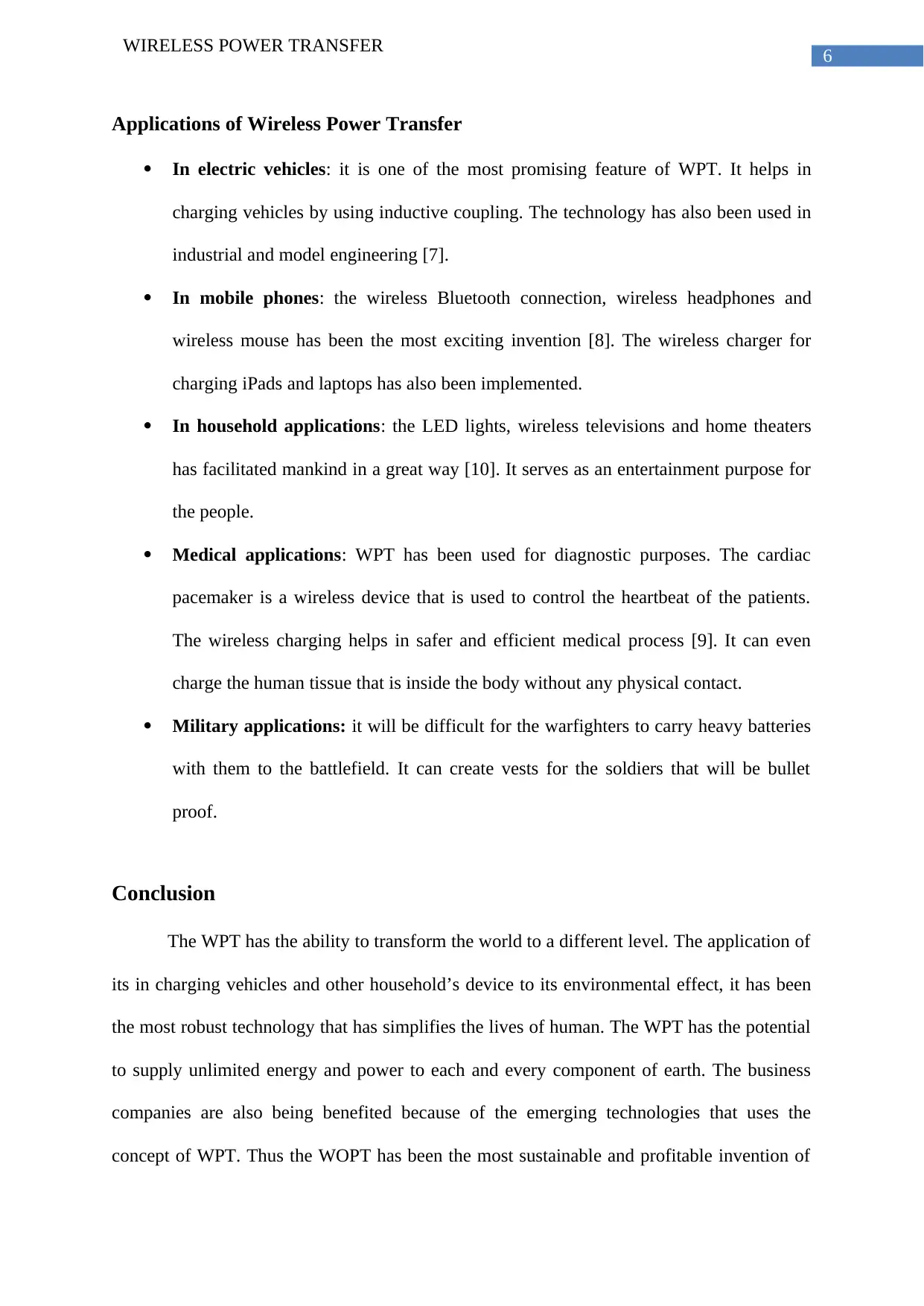
6
WIRELESS POWER TRANSFER
Applications of Wireless Power Transfer
In electric vehicles: it is one of the most promising feature of WPT. It helps in
charging vehicles by using inductive coupling. The technology has also been used in
industrial and model engineering [7].
In mobile phones: the wireless Bluetooth connection, wireless headphones and
wireless mouse has been the most exciting invention [8]. The wireless charger for
charging iPads and laptops has also been implemented.
In household applications: the LED lights, wireless televisions and home theaters
has facilitated mankind in a great way [10]. It serves as an entertainment purpose for
the people.
Medical applications: WPT has been used for diagnostic purposes. The cardiac
pacemaker is a wireless device that is used to control the heartbeat of the patients.
The wireless charging helps in safer and efficient medical process [9]. It can even
charge the human tissue that is inside the body without any physical contact.
Military applications: it will be difficult for the warfighters to carry heavy batteries
with them to the battlefield. It can create vests for the soldiers that will be bullet
proof.
Conclusion
The WPT has the ability to transform the world to a different level. The application of
its in charging vehicles and other household’s device to its environmental effect, it has been
the most robust technology that has simplifies the lives of human. The WPT has the potential
to supply unlimited energy and power to each and every component of earth. The business
companies are also being benefited because of the emerging technologies that uses the
concept of WPT. Thus the WOPT has been the most sustainable and profitable invention of
WIRELESS POWER TRANSFER
Applications of Wireless Power Transfer
In electric vehicles: it is one of the most promising feature of WPT. It helps in
charging vehicles by using inductive coupling. The technology has also been used in
industrial and model engineering [7].
In mobile phones: the wireless Bluetooth connection, wireless headphones and
wireless mouse has been the most exciting invention [8]. The wireless charger for
charging iPads and laptops has also been implemented.
In household applications: the LED lights, wireless televisions and home theaters
has facilitated mankind in a great way [10]. It serves as an entertainment purpose for
the people.
Medical applications: WPT has been used for diagnostic purposes. The cardiac
pacemaker is a wireless device that is used to control the heartbeat of the patients.
The wireless charging helps in safer and efficient medical process [9]. It can even
charge the human tissue that is inside the body without any physical contact.
Military applications: it will be difficult for the warfighters to carry heavy batteries
with them to the battlefield. It can create vests for the soldiers that will be bullet
proof.
Conclusion
The WPT has the ability to transform the world to a different level. The application of
its in charging vehicles and other household’s device to its environmental effect, it has been
the most robust technology that has simplifies the lives of human. The WPT has the potential
to supply unlimited energy and power to each and every component of earth. The business
companies are also being benefited because of the emerging technologies that uses the
concept of WPT. Thus the WOPT has been the most sustainable and profitable invention of
Paraphrase This Document
Need a fresh take? Get an instant paraphrase of this document with our AI Paraphraser
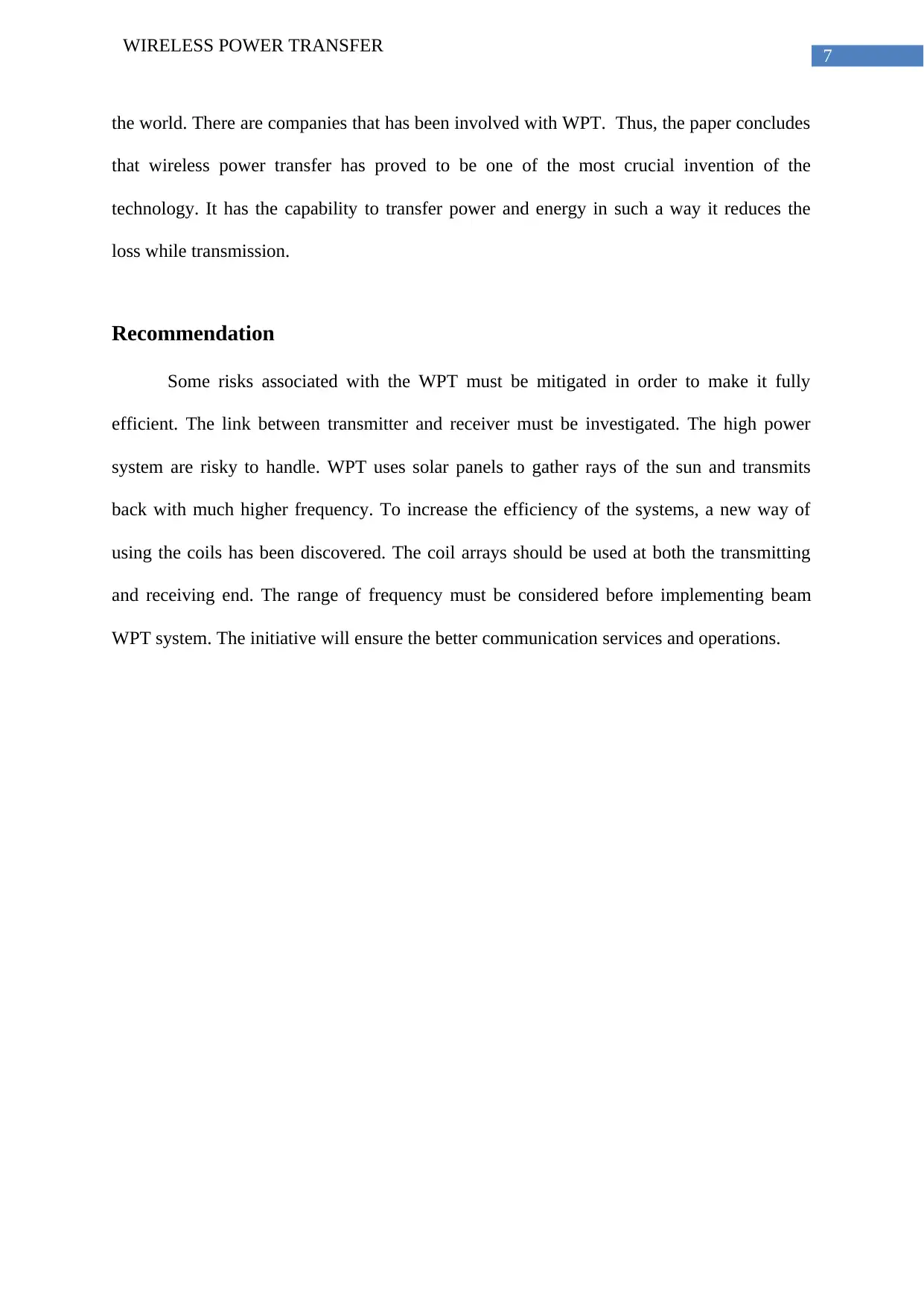
7
WIRELESS POWER TRANSFER
the world. There are companies that has been involved with WPT. Thus, the paper concludes
that wireless power transfer has proved to be one of the most crucial invention of the
technology. It has the capability to transfer power and energy in such a way it reduces the
loss while transmission.
Recommendation
Some risks associated with the WPT must be mitigated in order to make it fully
efficient. The link between transmitter and receiver must be investigated. The high power
system are risky to handle. WPT uses solar panels to gather rays of the sun and transmits
back with much higher frequency. To increase the efficiency of the systems, a new way of
using the coils has been discovered. The coil arrays should be used at both the transmitting
and receiving end. The range of frequency must be considered before implementing beam
WPT system. The initiative will ensure the better communication services and operations.
WIRELESS POWER TRANSFER
the world. There are companies that has been involved with WPT. Thus, the paper concludes
that wireless power transfer has proved to be one of the most crucial invention of the
technology. It has the capability to transfer power and energy in such a way it reduces the
loss while transmission.
Recommendation
Some risks associated with the WPT must be mitigated in order to make it fully
efficient. The link between transmitter and receiver must be investigated. The high power
system are risky to handle. WPT uses solar panels to gather rays of the sun and transmits
back with much higher frequency. To increase the efficiency of the systems, a new way of
using the coils has been discovered. The coil arrays should be used at both the transmitting
and receiving end. The range of frequency must be considered before implementing beam
WPT system. The initiative will ensure the better communication services and operations.
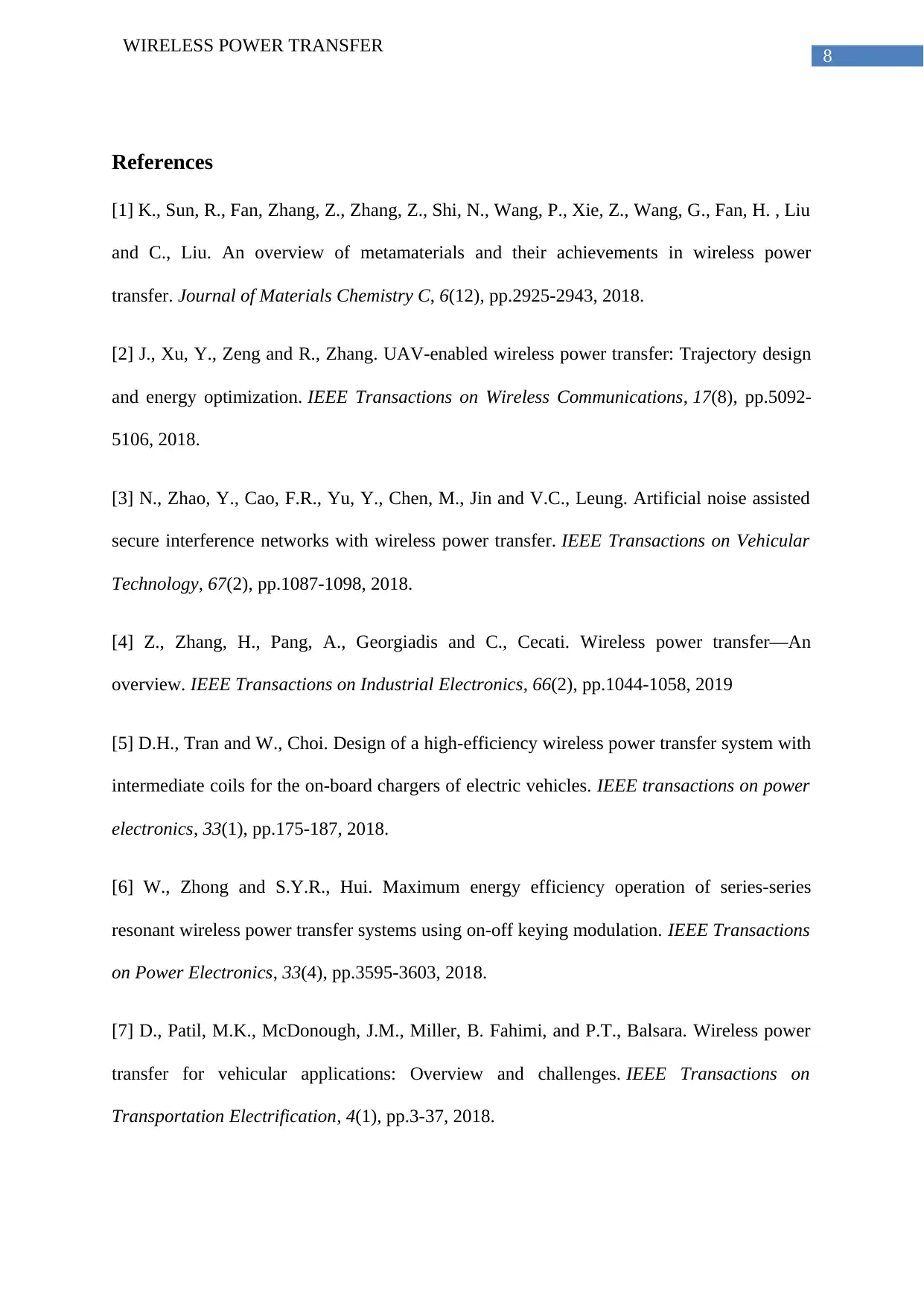
8
WIRELESS POWER TRANSFER
References
[1] K., Sun, R., Fan, Zhang, Z., Zhang, Z., Shi, N., Wang, P., Xie, Z., Wang, G., Fan, H. , Liu
and C., Liu. An overview of metamaterials and their achievements in wireless power
transfer. Journal of Materials Chemistry C, 6(12), pp.2925-2943, 2018.
[2] J., Xu, Y., Zeng and R., Zhang. UAV-enabled wireless power transfer: Trajectory design
and energy optimization. IEEE Transactions on Wireless Communications, 17(8), pp.5092-
5106, 2018.
[3] N., Zhao, Y., Cao, F.R., Yu, Y., Chen, M., Jin and V.C., Leung. Artificial noise assisted
secure interference networks with wireless power transfer. IEEE Transactions on Vehicular
Technology, 67(2), pp.1087-1098, 2018.
[4] Z., Zhang, H., Pang, A., Georgiadis and C., Cecati. Wireless power transfer—An
overview. IEEE Transactions on Industrial Electronics, 66(2), pp.1044-1058, 2019
[5] D.H., Tran and W., Choi. Design of a high-efficiency wireless power transfer system with
intermediate coils for the on-board chargers of electric vehicles. IEEE transactions on power
electronics, 33(1), pp.175-187, 2018.
[6] W., Zhong and S.Y.R., Hui. Maximum energy efficiency operation of series-series
resonant wireless power transfer systems using on-off keying modulation. IEEE Transactions
on Power Electronics, 33(4), pp.3595-3603, 2018.
[7] D., Patil, M.K., McDonough, J.M., Miller, B. Fahimi, and P.T., Balsara. Wireless power
transfer for vehicular applications: Overview and challenges. IEEE Transactions on
Transportation Electrification, 4(1), pp.3-37, 2018.
WIRELESS POWER TRANSFER
References
[1] K., Sun, R., Fan, Zhang, Z., Zhang, Z., Shi, N., Wang, P., Xie, Z., Wang, G., Fan, H. , Liu
and C., Liu. An overview of metamaterials and their achievements in wireless power
transfer. Journal of Materials Chemistry C, 6(12), pp.2925-2943, 2018.
[2] J., Xu, Y., Zeng and R., Zhang. UAV-enabled wireless power transfer: Trajectory design
and energy optimization. IEEE Transactions on Wireless Communications, 17(8), pp.5092-
5106, 2018.
[3] N., Zhao, Y., Cao, F.R., Yu, Y., Chen, M., Jin and V.C., Leung. Artificial noise assisted
secure interference networks with wireless power transfer. IEEE Transactions on Vehicular
Technology, 67(2), pp.1087-1098, 2018.
[4] Z., Zhang, H., Pang, A., Georgiadis and C., Cecati. Wireless power transfer—An
overview. IEEE Transactions on Industrial Electronics, 66(2), pp.1044-1058, 2019
[5] D.H., Tran and W., Choi. Design of a high-efficiency wireless power transfer system with
intermediate coils for the on-board chargers of electric vehicles. IEEE transactions on power
electronics, 33(1), pp.175-187, 2018.
[6] W., Zhong and S.Y.R., Hui. Maximum energy efficiency operation of series-series
resonant wireless power transfer systems using on-off keying modulation. IEEE Transactions
on Power Electronics, 33(4), pp.3595-3603, 2018.
[7] D., Patil, M.K., McDonough, J.M., Miller, B. Fahimi, and P.T., Balsara. Wireless power
transfer for vehicular applications: Overview and challenges. IEEE Transactions on
Transportation Electrification, 4(1), pp.3-37, 2018.
⊘ This is a preview!⊘
Do you want full access?
Subscribe today to unlock all pages.

Trusted by 1+ million students worldwide
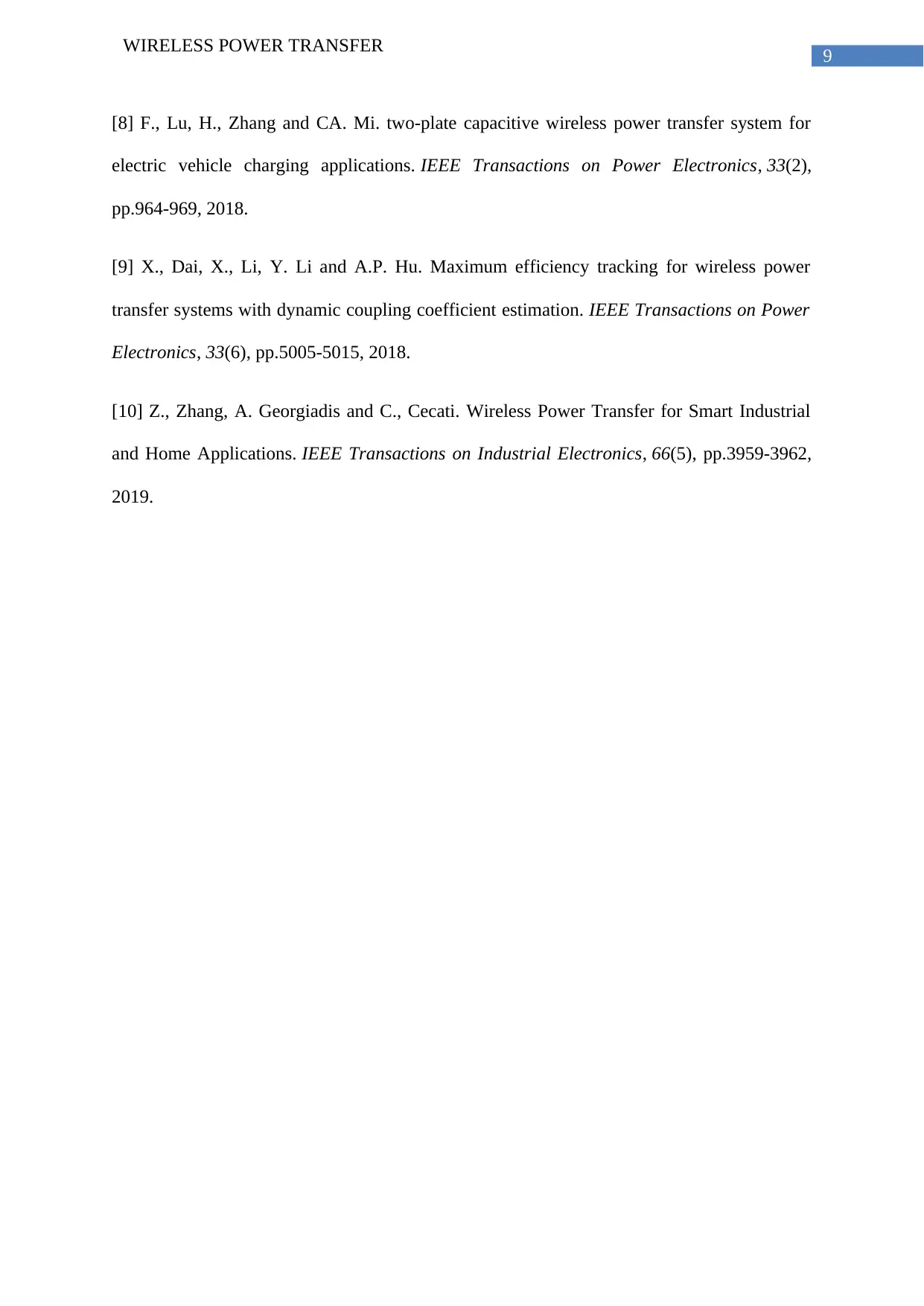
9
WIRELESS POWER TRANSFER
[8] F., Lu, H., Zhang and CA. Mi. two-plate capacitive wireless power transfer system for
electric vehicle charging applications. IEEE Transactions on Power Electronics, 33(2),
pp.964-969, 2018.
[9] X., Dai, X., Li, Y. Li and A.P. Hu. Maximum efficiency tracking for wireless power
transfer systems with dynamic coupling coefficient estimation. IEEE Transactions on Power
Electronics, 33(6), pp.5005-5015, 2018.
[10] Z., Zhang, A. Georgiadis and C., Cecati. Wireless Power Transfer for Smart Industrial
and Home Applications. IEEE Transactions on Industrial Electronics, 66(5), pp.3959-3962,
2019.
WIRELESS POWER TRANSFER
[8] F., Lu, H., Zhang and CA. Mi. two-plate capacitive wireless power transfer system for
electric vehicle charging applications. IEEE Transactions on Power Electronics, 33(2),
pp.964-969, 2018.
[9] X., Dai, X., Li, Y. Li and A.P. Hu. Maximum efficiency tracking for wireless power
transfer systems with dynamic coupling coefficient estimation. IEEE Transactions on Power
Electronics, 33(6), pp.5005-5015, 2018.
[10] Z., Zhang, A. Georgiadis and C., Cecati. Wireless Power Transfer for Smart Industrial
and Home Applications. IEEE Transactions on Industrial Electronics, 66(5), pp.3959-3962,
2019.
1 out of 10
Related Documents
Your All-in-One AI-Powered Toolkit for Academic Success.
+13062052269
info@desklib.com
Available 24*7 on WhatsApp / Email
![[object Object]](/_next/static/media/star-bottom.7253800d.svg)
Unlock your academic potential
Copyright © 2020–2025 A2Z Services. All Rights Reserved. Developed and managed by ZUCOL.





